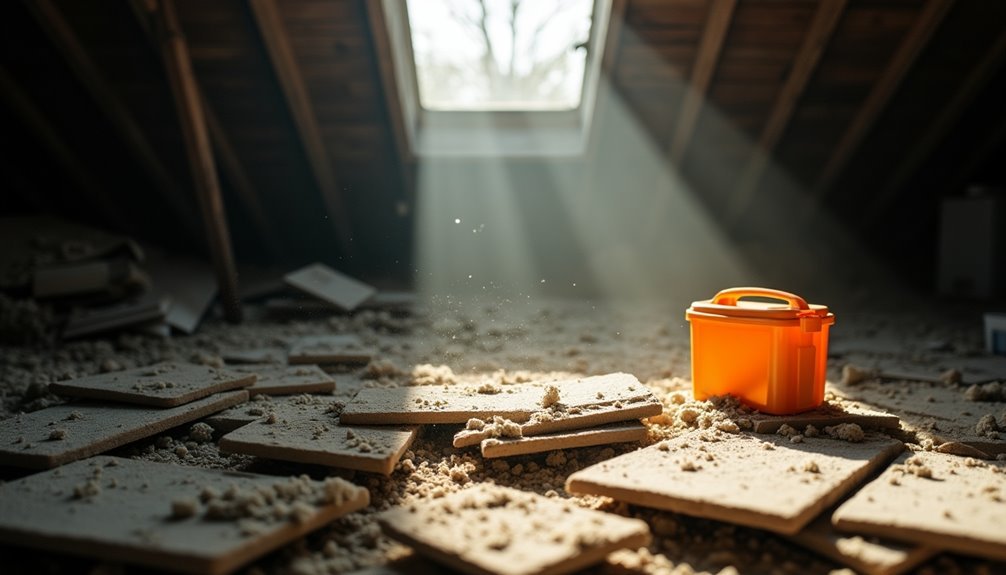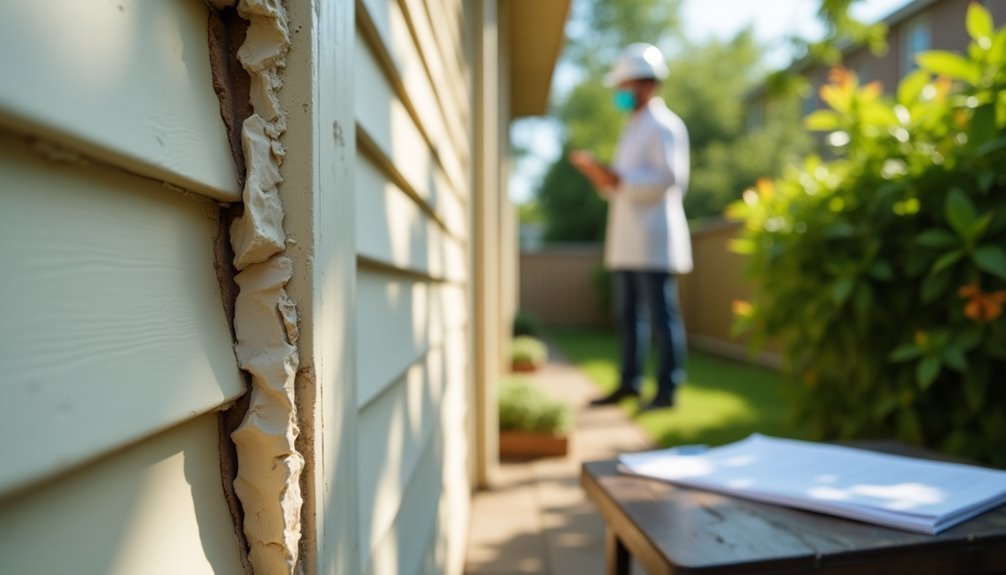Asbestos testing is essential for your health and home safety. It identifies harmful asbestos fibers that could lead to serious diseases like mesothelioma and lung cancer. Homes built between the 1940s and 1980s are particularly vulnerable, making professional testing vital. Beyond health concerns, it ensures compliance with legal requirements before renovations, helping you avoid costly penalties. Testing also improves air quality and can enhance your property's value by confirming its safety. Don't wait for symptoms to arise—understanding the risks and benefits of testing can significantly impact your well-being. Discover more about how to navigate asbestos issues effectively.
Understanding Asbestos Risks

Understanding the risks associated with asbestos is crucial, especially since nearly 1,300 Americans die from asbestos-related diseases each year. Asbestos exposure is a significant health hazard, classified as a known carcinogen by leading health organizations. It heightens the risk of serious conditions like mesothelioma and lung cancer, which often manifest decades after initial exposure. Even nonmalignant lung disorders, like asbestosis, can lead to severe health consequences, causing permanent damage to your lungs and reducing oxygen supply.
The severity of health risks tied to asbestos exposure isn't uniform; factors such as the amount and duration of exposure play a critical role. Additionally, individual characteristics like smoking history or pre-existing lung diseases can amplify these risks. While some links to digestive cancers exist, they remain less conclusive. Two main groups of asbestos include serpentine and amphibole, and understanding these types can further inform your decisions regarding safety and testing.
Awareness of these dangers empowers you to take control of your environment and health. Understanding the potential long-term impacts of asbestos exposure can significantly influence your choices, helping you pursue a safer, healthier living space. Don't underestimate the importance of knowledge in liberating yourself from potential harm.
Recognizing Asbestos in Your Home
When assessing your home for asbestos, knowing where to look is essential. Homes built between the 1940s and 1980s are particularly at risk, as many common asbestos materials were widely used during that time. Inspect your attic, especially if it contains vermiculite insulation, which may be contaminated with asbestos. In basements, check boiler insulation and pipe wraps. Your ceilings might also hide asbestos, particularly in ceiling tiles or acoustic tiles. Don't forget crawl spaces and flooring, where vinyl tiles or cement flooring could contain hazardous materials. Additionally, it's important to note that common insulation types such as loose-fill and pipe wrap may contain asbestos, increasing the likelihood of exposure in these areas.
Utilizing effective asbestos identification techniques can help you pinpoint potential risks. Check product labels and manufacturing dates, as materials produced before 1984 often contain asbestos. Research products and their manufacturers online for additional insights. Be cautious with visual identification, as it can be unreliable; hiring a trained professional for testing is always a safer choice. Self-sampling can expose you to harmful fibers, so sending samples to a lab for definitive analysis is recommended. By being vigilant and informed about these common asbestos materials, you can take crucial steps toward protecting your health and home.
Importance of Asbestos Testing

Asbestos testing is crucial for safeguarding your health and ensuring compliance with legal regulations. This process not only protects workers and residents from exposure risks but also aids in the identification and management of hazardous materials. Understanding the health impacts associated with asbestos is essential, as even minimal exposure can lead to severe diseases such as lung cancer and mesothelioma.
| Aspect | Importance | Consequences |
|---|---|---|
| Health Protection | Identifies asbestos presence | Prevents serious health issues |
| Legal Compliance | Mandatory before renovations | Avoids legal penalties |
| Environmental Safety | Monitors air quality | Protects ecological health |
| Financial Benefits | Reduces unexpected costs | Increases property value |
Safe Handling Practices
Proper handling practices are vital for minimizing the risks associated with asbestos exposure. When you're working with asbestos-containing materials, always wear appropriate personal protective equipment (PPE), such as NIOSH-approved respirators (N100 or P100), coveralls, gloves, and a hat. This gear must be removed and disposed of properly to prevent carrying asbestos fibers home. After completing your work, shower and wash your hair immediately to eliminate any lingering particles.
Before starting, prepare your work environment by isolating the area with sealed internal doors and keeping external doors or windows open to enhance ventilation. Cover the floor with heavy-duty plastic sheeting to catch any dust or debris. Always wet down asbestos materials thoroughly before handling them, using non-powered hand tools to minimize dust generation. Carefully lower sheets to the ground, stacking them on polythene sheeting for safe disposal.
Double bag all waste in 0.2 mm thick heavy-duty polythene bags, ensuring that you don't spread asbestos dust to unprotected areas. Following these safe handling practices is essential for protecting your health and achieving safe disposal of hazardous materials.
Legal Regulations and Responsibilities

Understanding legal regulations and responsibilities surrounding asbestos is crucial for anyone involved in construction, renovation, or property management. You have legal obligations to conduct thorough asbestos surveys before any demolition or renovation work begins. These surveys must be carried out by licensed asbestos contractors and certified inspectors to identify any asbestos-containing materials (ACM) or presumed ACM (PACM).
Regulatory compliance is non-negotiable; you must submit survey results to local government entities and maintain a copy on-site during the project. Exemptions do exist, but they don't absolve you from adhering to EPA and OSHA standards. For instance, if you're demolishing a building without an asbestos survey, you'll need to assume it contains asbestos unless certified otherwise.
Moreover, you must notify prospective tenants and employees about the presence of asbestos, including its location and quantity. This transparency is vital for safety and legal compliance. In special cases, such as schools, compliance with the Asbestos Hazard Emergency Response Act (AHERA) is necessary to ensure proper management of asbestos materials. Understanding these regulations not only protects your health but also safeguards your legal standing.
Conclusion
In the realm of home safety, asbestos testing acts as a protective shield against hidden dangers. By identifying and mitigating asbestos risks, you're not just safeguarding your health but also preserving your home's integrity. Ignoring these potential hazards is like playing with fire; the consequences can be severe. Prioritize testing and safe handling practices to ensure a secure environment for you and your loved ones. Stay informed, comply with regulations, and breathe easier in your space.
